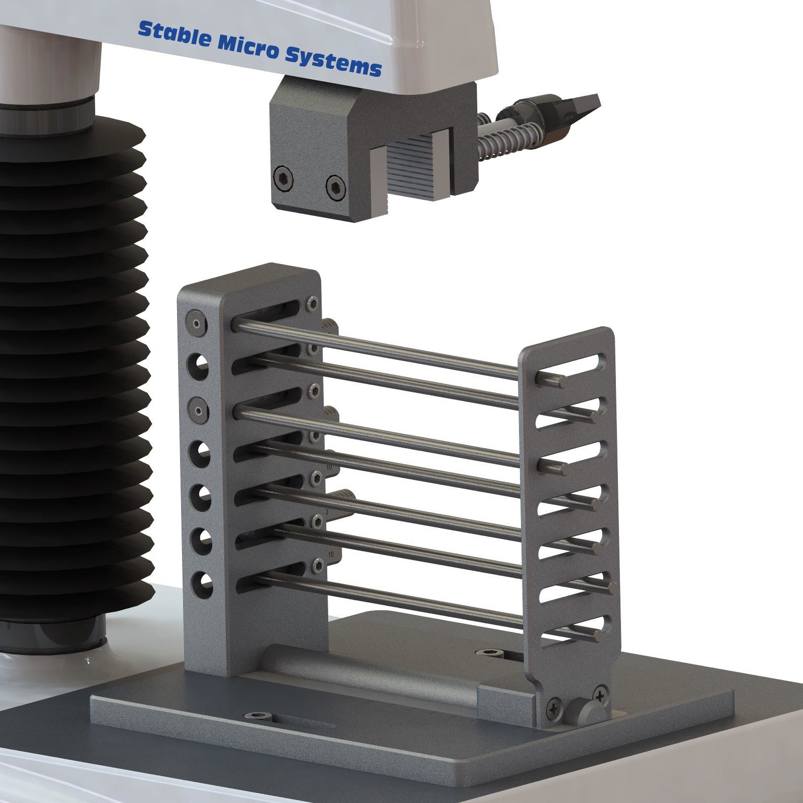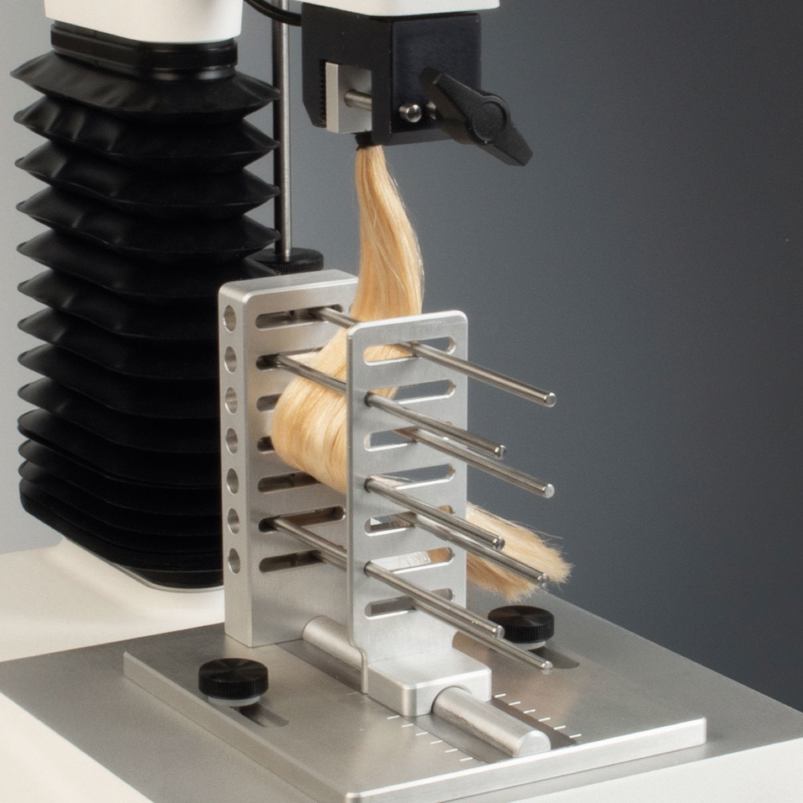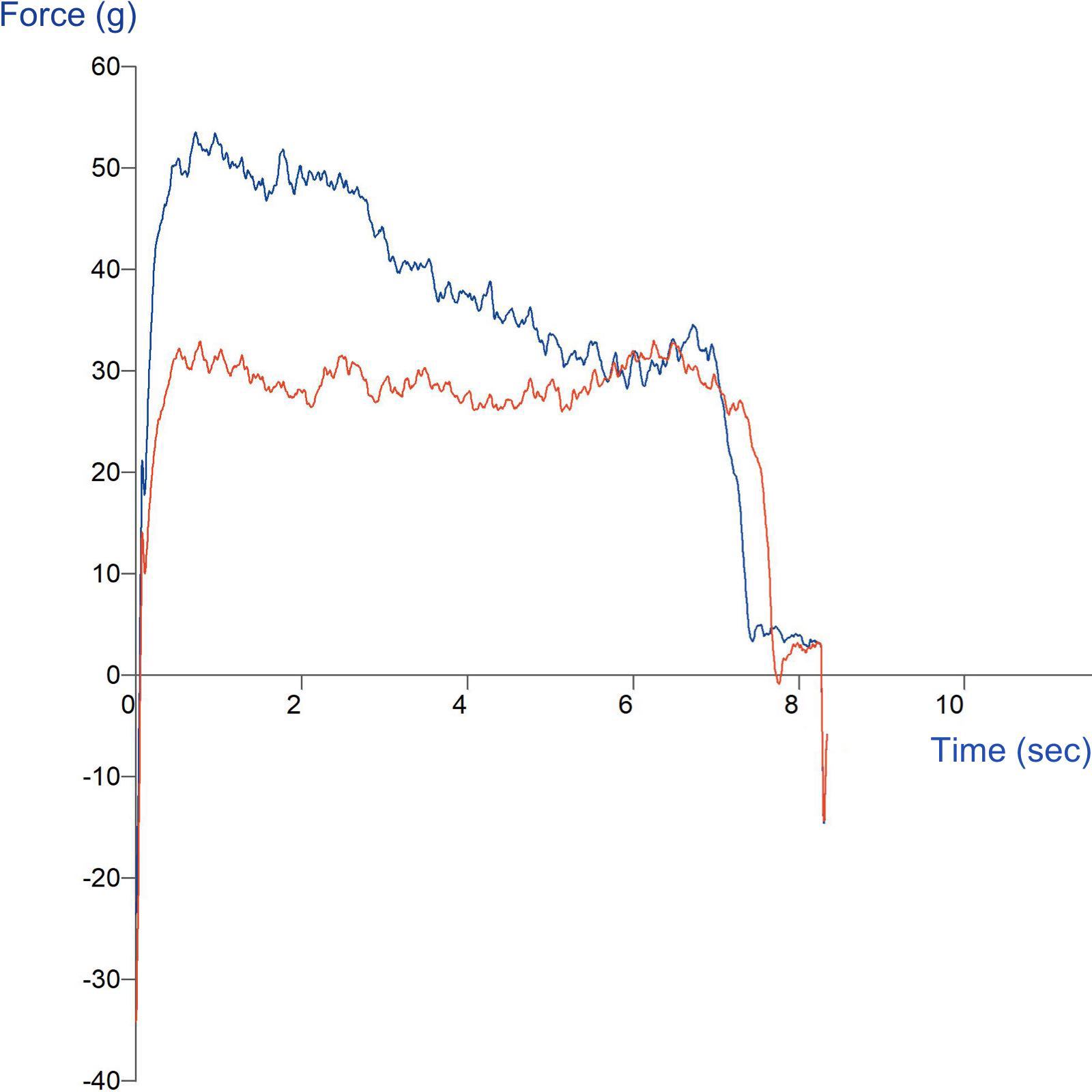Product overview
The cosmetics industry frequently promises softer, suppler hair after the use of their products, or promises that certain traditionally harmful methods (such as bleaching) will have no adverse effect. The difficulty comes in testing these properties in an imitative, repeatable way. The Hair Suppleness Rig allows the measurement of the resistance of a hair sample to being run through a set of smooth bars, representative of running fingers through the hair on a human head.
Some changes to the physical properties of hair are intentional (the addition of conditioners or serum for added smoothness), whereas some are unintentional (bleaching, which induces brittleness and stiffness). No matter the property in question, the quantification of hair properties is important to the development of new hair products and treatments. Sensory panels are useful, as hair is a product with a complex pattern of properties and variables, so it is a challenge to measure its properties exactly as a consumer might feel them when they are styling their hair, or what they take to mean 'softness to the touch'. However, instrumental testing is much faster to perform, and the results of an instrumental test do not rely on the operator, unlike those of a sensory test, no matter how thorough sensory training has been. Consequently, instrumental quantification of hair properties should be a standard part of any hair testing regimen.
Assessments of hair such as tensile testing and three-point bend testing are useful for keeping a record of more fundamental properties, but imitative tests such as the measurement of combing force, volume and body measurement via laser profiling, and this suppleness test are useful for representing hair in the way in which it is felt and used in reality.
The force detected by the Load Cell when a hair sample is pulled through this rig is made up of several factors:
- The stiffness of the hair fibres (as they have to constantly bend on their way up through the rods).
- The friction between hair strands (as they rub against each other constantly when the tress is being pulled upward).
- The friction between the hair strands and the rig (as they are pulled against the surface of the rig itself).
An alteration to any of these factors will have an effect on the measured force. A higher force represents a higher resistance to motion through the rods of the rig. A suppler hair sample will have a lower resistance to motion, and in turn, suppler hair on a person's head feels flexible and smooth when fingers are run through it. This is similar to subjecting a sample to a three-point bend test, but the bending configuration is slid along the length of the tress i.e., continuous three point bending. Bending tests can be challenging to set up in a reproducible way, particularly for suppler samples that cannot support their own weight without drooping, so this test is a simpler alternative that can be directly related to the consumer's perception of their own hair texture.
Ideal sample form
Hair tresses.
Benefits and limitations
- Configurable rods for differing bending.
- The hair tress length should optimise the available tensile distance of the instrument.
Technical information
Installation
Full installation instructions are provided within the Education Zone of the latest Exponent/Connect software version and on the technical information sheet accompanying this product.
Chemical compatibility
Stable Micro Systems probes and attachments are commonly made from four materials: anodised aluminium (AA6082 T6), stainless steel (316 T), Delrin (acetyl copolymer) and Perspex (polycarbonate).
In general use, probes and attachments made from these materials will be suitable for testing food products and inert non-food materials.
The four materials listed above are not universally resistant to all types of chemicals and as such the compatibility of the probe/attachment material with the product (to be tested) must be established to prevent damage to the probes and attachments. If the compatibility of the product with the probe is unknown to the customer then the chemical information about the product (Material Safety Data Sheet or Product Data Sheet) should be submitted to Stable Micro Systems. Stable Micro Systems will then assess the suitability of the probe/attachment material for use with the product and advise accordingly. If this advice is not sought then Stable Micro Systems will not accept liability for probes/attachments damaged by chemical attack from the product being tested.
Cleaning and maintenance
All probes and attachments may be cleaned in warm (or hand hot) water using a mild detergent. A soft brush may be used but abrasive cleaning aids should be avoided. Stable Micro Systems products should not be microwaved or cleaned in a dishwasher.
Screw threads should be lightly lubricated after drying using a light lubricant, e.g. petroleum jelly, mineral oil. This will aid the fitting and unscrewing of the item. Each component of a probe or attachment should be wrapped separately when stored, to avoid scratching or chipping. This will safeguard against any unnecessary damage to the accessory.



